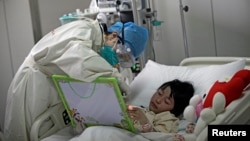Scientists researching a new strain of bird flu in eastern China are reporting the first case of probable person-to-person transmission of the so-called H7N9 virus.
The findings were reported Tuesday in the British Medical Journal and focus on the case of an adult woman and her 60-year-old father, who became ill in March after a routine visit to a live poultry market. Despite medical care and eventual hospitalization, the father died six weeks later.
Researchers say most patients appear to have visited live poultry markets or otherwise had close contact with live birds seven to 10 days before the onset of the illness, which has sickened more than 100 people and resulted in 43 deaths since first appearing in March.
In the father-daughter case, the report says the previously healthy 32-year-old woman had no direct exposure to live poultry. But she provided direct and unprotected bedside care for her ailing father, and became sick about a week after her last contact with him. She died one month later.
Despite the fatalities, the report stresses that the ability of the virus to transmit itself still appears "limited and non-sustainable."
It also says medical investigators interviewed 43 close contacts with the father and daughter - all of whom were tested for the virus. All tested negative.
In April, Chinese scientists said they feared that H7N9 had in some cases spread from human to human. The World Health Organization later said there was no firm evidence, though, that this was the case.
Chinese scientists have scrambled to develop vaccines and other treatments for the H7N9 strain, while health authorities earlier this year slaughtered hundreds of thousands of birds in live markets to bring the outbreak under control.
China's official Xinhua news agency said emergency virus control procedures were lifted in May in eastern provinces and major cities, including Shanghai, Jiangsu and Shandong, where most of the infections occurred.
A more common form of avian flu, H5N1, has killed more than 360 people worldwide in the past decade.
The findings were reported Tuesday in the British Medical Journal and focus on the case of an adult woman and her 60-year-old father, who became ill in March after a routine visit to a live poultry market. Despite medical care and eventual hospitalization, the father died six weeks later.
Researchers say most patients appear to have visited live poultry markets or otherwise had close contact with live birds seven to 10 days before the onset of the illness, which has sickened more than 100 people and resulted in 43 deaths since first appearing in March.
In the father-daughter case, the report says the previously healthy 32-year-old woman had no direct exposure to live poultry. But she provided direct and unprotected bedside care for her ailing father, and became sick about a week after her last contact with him. She died one month later.
Despite the fatalities, the report stresses that the ability of the virus to transmit itself still appears "limited and non-sustainable."
It also says medical investigators interviewed 43 close contacts with the father and daughter - all of whom were tested for the virus. All tested negative.
In April, Chinese scientists said they feared that H7N9 had in some cases spread from human to human. The World Health Organization later said there was no firm evidence, though, that this was the case.
Chinese scientists have scrambled to develop vaccines and other treatments for the H7N9 strain, while health authorities earlier this year slaughtered hundreds of thousands of birds in live markets to bring the outbreak under control.
China's official Xinhua news agency said emergency virus control procedures were lifted in May in eastern provinces and major cities, including Shanghai, Jiangsu and Shandong, where most of the infections occurred.
A more common form of avian flu, H5N1, has killed more than 360 people worldwide in the past decade.









